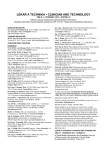Vývojové poruchy zubů a jejich diagnostika pomocí rentgenových snímků
Authors:
E. Kaplová 1; P. Krejčí 1; K. Tománková 2; H. Kolářová 2; L. Kramerová 1
Authors‘ workplace:
Klinika zubního lékařství, Lékařská fakulta, Univerzita Palackého v Olomouci
1; Klinika lékařské biofyziky, Lékařská fakulta, Univerzita Palackého v Olomouci
2
Published in:
Lékař a technika - Clinician and Technology No. 4, 2013, 43, 23-27
Category:
Original research
Overview
Introduction:
The Development of dentition begins in sixth week of intrauterine life with making the dentogingival lamina, that gives the origin to tooth germs. If the insult operates in these early stages of development, it can result in termination of the development of tooth, the disorder in later development manifests as a malformation of tooth- the anomaly of shape, size, defects of hard dental tissues, variations in eruption, etc. The development of tooth is related to the development of the whole organism, therefore the failure of the overall development interferes with the development of teeth. Except to system failures can play a big role local factors such as trauma and inflammation. The differentiation between local and systemic causes of the anomaly can be very difficult.
Methods:
An indispensable component in diagnostic and as a tool for screening of disorders of impacted teeth is the radiographic examination. In dentistry we use intraoral RVG images, OPG panoramic image and for 3D imaging CBCT and CT.
Results:
Atomic force microscopy (AFM) was used to study the enamel surface of extracted teeth in order to compare the structure of malformed and healthy enamel.
Conclusion:
Developmental disorders of the teeth and dental hard tissues are relatively common clinical practice and their diagnostics and therapy is usually not an easy task. It is often found as an incidental finding on chest radiograph. Atomic force microscopy provides high-resolution images and is an important source of information about the structure of human enamel.
Keywords:
Malformation of tooth, X- ray examination, tooth development, DDE, AFM
Sources
[1] Andreasen, J. O. Injuries to developing teeth, p. 470-473.
[2] Broadbent, J. M., Thomson, W. M., Williams, S. M.: Does caries in primary teeth predict enamel defect in permanent teeth? A lingitudinal study. J. Dent. res., 2005, vol. 84, no. 3, p. 260-264.
[3] Černochová, P., Kaňovská K., Kuklová J. Následky onemocnění dočasného chrupu ve stálé dentici. Prakt. zub. lék., vol. 49, p. 75-80.
[4] Farina, M., Schemmel, A., Weissmuller, G., Cruz, R., Kachar, B., Bisch, P. M. Atomic force microscopy study of tooth surfaces. Journal of Structural Biology. 1999, vol. 125, p. 39–49.
[5] Fawcet D in Fawcet DW (Ed.) A Text Book of Histology, Saunders, Philadelphia, PA, 1989; p. 602- 618.
[6] Fleischmannová J., Krejčí P., Matalová E., Míšek I.: Molekulární podstata vývoje zubních zárodků Orthodoncie 2007, vol. 16, n. 4, p. 39-46.
[7] Kaplova E., Krejci, P., Tomankova, K., Kolarova, H.: Study of developmental enamel defects of permanent teeth by atomic force microscopy, Current microscopy contributions to advances in science and technology, 2012, vol. 1, p. 555-560.
[8] Kearns, H. P. Dilacerated incisors and congenitally displaced incisors: three case reports. Dental Update, 1998, p. 339-342.
[9] Kilian, J. Úrazy zubů u dětí. Praha: Avicenum/Zdrav. nakl. 1985, p. 191-197.
[10] Kodaka, T., Kuroiwa and Higashi, S. Structural and distribution patterns of surface ‘‘prismless’’ enamel in human permanent teeth. Caries Res. 1991, vol. 25, p. 7–20.
[11] Krejčí, P.: Retence řezáku jako následek úrazu dočasného zubu. Čes. Stomat., 2001, vol. 101, no. 3, p. 81-87.
[12] Krejčí, P., Fleischmannová, J., Matalová, E., Míšek, I.: Molekulární podstata hypodoncie, Ortodoncie 2007, vol. 16, n. 1, p. 33-39.
[13] Mc Collum M. A., Sharpe P. T.: Developmental genetics and early hominid craniodental evolution.Bioessays. 2001, vol. 23, p. 481-493.
[14] Merglová V.: K problematice poruch tvorby tvrdých zubních tkání a prořezávání zubů. Prakt. zub Lék. 2010, vol. 58, p. 5-38.
[15] Pasler, A. F., Visser, H. Stomatologická radiologie - kapesní atlas, Grada publishing a.s., 2007, p. 2-6.
[16] Pindborg, J. J. Pathology of the Dental Hrad Tissues. Copenhagen: Munksgaard, 1970, p. 126.
[17] Poggio, C., Lombardini, M., Colombo, M., Bianchi, S. Impact of two toothpastes on repairing enamel erosion produced by a soft drink: An AFM in vitro study. Jurnal of dentistry. 2010, vol. 38, p. 868-874.
[18] Suckling, G. W. Developmental defects of enamel - historical and present-day perspectives of their pathogenesis. Adv. Dent. Res. 1989; vol. 3, n. 2, p. 87-94.
[19] Suckling, G. W., Nelson, D. G. A., Patel, M. J. Macroscopic and scanning electron microscopic appearance and hardness values of developmental defects in human permanent tooth enamel. Adv. Dent. Res. 1989, vol. 3, n. 2, p. 219-233.
[20] Turner, J. O. Effects of abscess arising from temporary teeth. Br. J. Dent. Sci., 1906, vol. 49, p. 562-564.
[21] Turner, J. O. Two cases of hypoplasia of enamel. Br. J. Dent. Sci., 1942, vol. 55, p. 227-228.
[22] Weber, T. Memorix zubního lékařství, Grada publishing a.s., 2006, p. 97.
Labels
BiomedicineArticle was published in
The Clinician and Technology Journal

2013 Issue 4
Most read in this issue
- Vývojové poruchy zubů a jejich diagnostika pomocí rentgenových snímků
- Metodika merania na celotelovom 3D skenery a možnosti aplikácie
- Termografické hodnocení radiofrekvenční ablace stentů ex vivo
- Utilizing of MEMS sensors in rehabilitation process
